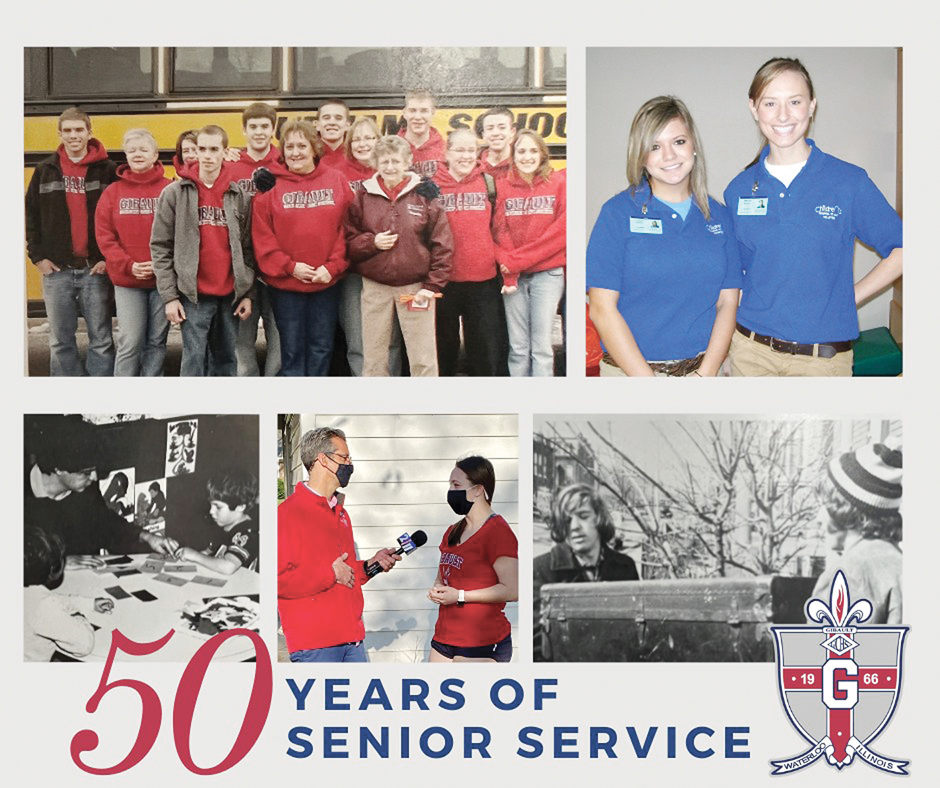On Feb. 18, Fr. Linus Umoren, C.M., pastor of S.S. Peter and Paul Parish in Waterloo, blessed Gibault Catholic High School’s Class of 2022 and sent them out into the community for their three-week senior service project.
This year marks the 50th Anniversary of Gibault’s inaugural senior service project held in 1972, a program school officials call “one of the most important components of Catholic education.”
“That is 150 weeks of Gibault students serving others,” Principal Steve Kidd told students during the annual pre-service project assembly and prayer service.
Father Linus blessed crosses and the principal gave one to each senior, which they were encouraged to wear during their service project.
One of the speakers at the prayer service was Greg Lane, a former teacher at Gibault credited with helping start the senior service project.
“They thought Greg was crazy to send seniors out into community,” Kidd said. “But the project has become one of things that seniors look forward to beginning in their freshmen year. Everyone remembers and talks fondly about what they did on their senior service project. It has really become a transformative part of the Gibault formational experience.”
During his talk, Lane explained why the senior service project was started and encouraged the seniors to find their purpose during their project.
“Its true mission was to enable students to select their project, learn about themselves and find their purpose in the world,” Lane said. “It was not so much that they should go and find out about the poor and disadvantaged, but rather find out about themselves and how they could serve.”
According to Religion instructor Liz LeSaulnier, the objectives of the service project haven’t changed much over 50 years. Those objectives are:
• To transform students by using their talents for the benefit of others.
• To become actively involved in the Church’s mission to work for justice.
• To involve students in active learning in which they take the initiative and become more committed to addressing the social needs of the community.
• To make abstract learning more meaningful.
• To give students first-hand experience of social problems.
Besides the three-week senior service project, all students must participate in class retreats and complete 10 hours of service each year they are in attendance.
Kidd says as a Catholic school, service is embedded in the school’s mission.
“Service is something we believe is part of our Catholic education and identity,” he said. “We want to teach our students to be service-first oriented people.”
All three diocesan high schools have senior service components. The schools stagger the service dates because many of the students serve at diocesan schools or local non-profits. “We don’t want them bumping into each other,” Kidd said.
Kidd says that when he talks to graduates of Gibault they often tell him that they took away valuable lessons from the senior service project, lessons that have lasted throughout their lives.
“Everyone I talk to when they come back to Gibault for whatever reason, always says the project was different than they expected, and they all say they were touched in a way that they became a part of something—not so much about three weeks out of school—but about learning the value of service and the appreciation that people have. Our hope is this becomes a habit.”
LeSaulnier guides the students through the process with help from Susan Mackin, guidance counselor. Students are provided with a list of places that typically welcome them into their school or agency, then students make their choice, call the school or agency, and go in for an interview. During the project they write reflections on their day-to-day activities. After then the project ends, they summarize their experience.
Finally there is a Welcome Back Ceremony in the Gibault gym, during which a few students will talk about their service and experience.
Over the years seniors have traveled far and wide for their service projects. A partial list includes: Salvatorian Mission Warehouse, New Holstein, Wisc.; a Navajo reservation in Arizona; La Paz, Bolivia, as well as many Central American countries.
“Our seniors have traveled the country from New Mexico to Winnebago, Neb., to work in grade schools, daycare centers, orphanages, Indian reservations, hospitals, penitentiaries and with environmental groups,” Lane added. “It has been a joy to research the last 50 years with people now in their mid-sixties and find out that their lifestyles have changed and they’ve learned what it has meant to be given the task of serving others and giving of themselves generously to those without the basics that our society has to offer.”
Many Gibault alumni weighed in on social media to recall their senior service project.
Barb Matzenbacher wrote that her service project at St. Augustine Indian Mission in Winnebago, Nebraska, was “one of the most rewarding things I have ever done!”
And Mary Kay Reinhold wrote: “Friends Barb Kayser Miller and Marcy Meyer Dunker and I spent our days and nights at Hoyleton Children’s Home in 1973. It was an unforgettable experience!”







